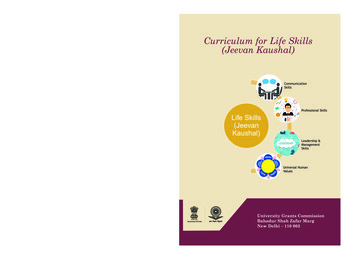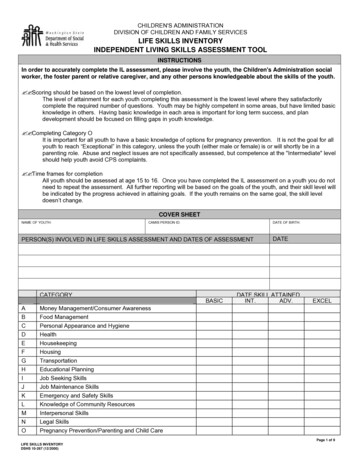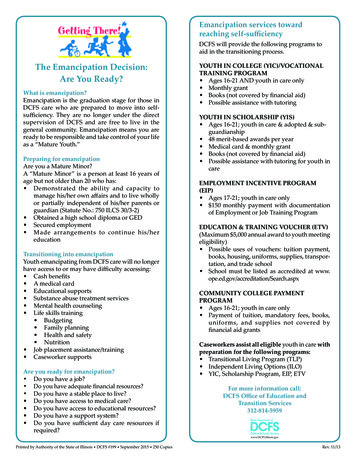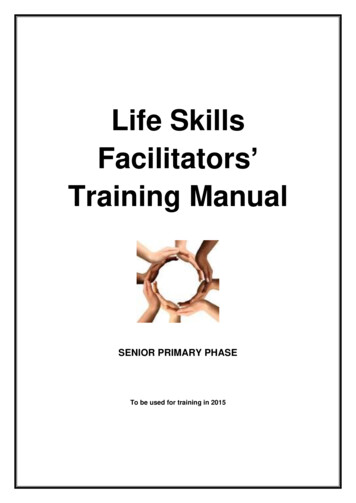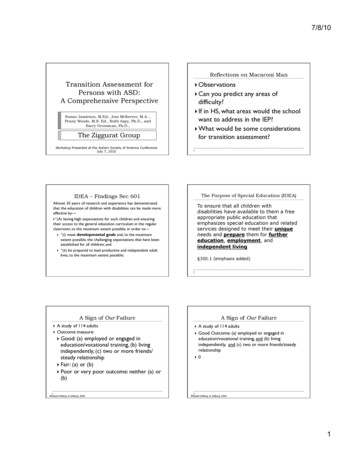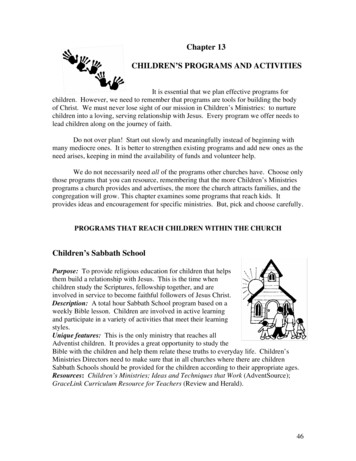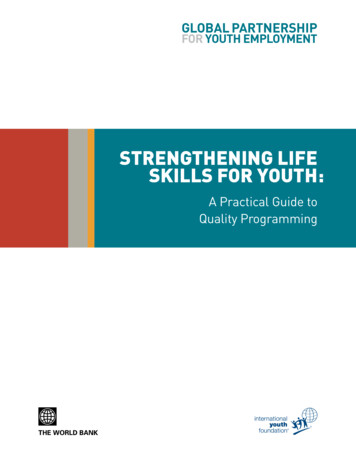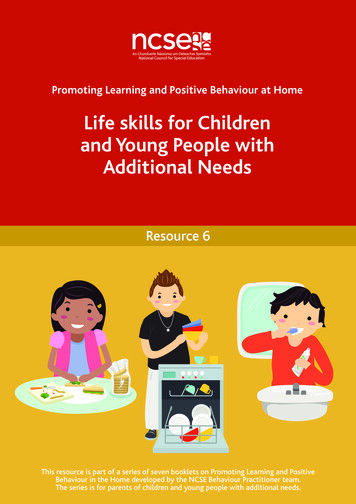
Transcription
Promoting Learning and Positive Behaviour at HomeLife skills for Childrenand Young People withAdditional NeedsResource 6This resource is part of a series of seven booklets on Promoting Learning and PositiveBehaviour in the Home developed by the NCSE Behaviour Practitioner team.The series is for parents of children and young people with additional needs.
ContentsWhat are Life Skills?1Task Analysis2Steps for Breaking Down a Task for Your Child3Top Tips!5Useful Websites5Useful Videos5References5Booklets in the seriesResource 1:Behaviour Support Pack for Children and Young Peoplewith Additional NeedsResource 2:Home Routines for Children and Young Peoplewith Additional NeedsResource 3:Using Reward Systems for Children and Young Peoplewith Additional NeedsResource 4:Behaviour Contracts for Children and Young Peoplewith Additional NeedsResource 5:A Total Communication Approach for Children and Young Peoplewith Additional NeedsResource 6: Life Skills for Children and Young Peoplewith Additional NeedsResource 7:Transitioning for Children and Young Peoplewith Additional Needs
What are Life Skills?Life skills are often referred to as independent living skills or daily living skills. Basic lifeskills include self-care activities, communicating with others, cooking, money management,shopping, keeping a room clean and organised and so on. These skills are learned over time,beginning at home at a very young age and developing further throughout adolescenceand adulthood.The overall aim in supporting children and young people with additional needs is to developlife skills and link these skills together to promote independence in all possible aspects oftheir lives. This builds self-esteem and confidence and ensures a sense of achievement whichin turn increases happiness and wellbeing.The tasks associated with learning life skillsare complex and can involve many steps frombeginning to end. Sometimes your child mayneed help to learn the skills involved. Breakingtasks down into smaller, more manageablesteps is an effective strategy when teachingthe skills. We call this task analysis. We all usetask analysis at different times, for exampleusing a recipe to make a cake or followinginstructions to assemble a piece of furniture.Life skills for Children and Young People with Additional Needs1
Task AnalysisTo design a task analysis for your child, you need to write down all the steps involvedin an activity. These written steps are the plan you use to guide your child whencompleting the task. Using visual supports and/or verbal prompts can also help yourchild to understand each step involved in learning a skill. These supports demonstratethe sequence of the task for your child. Refer to the booklets on Home Routines andTransitioning for more information.Simple ideas for the design of a task analysis:Using the ToiletToiletTurn onlightShutdoorSit ontoiletWipe withtoilet paperFlushtoiletWashhandsRub handswith soapRinsehandsWater offDry handsWashing HandsWater onWet handsBrushing TeethGettoothbrush2WettoothbrushPuttoothpasteon brushLife skills for Children and Young People with Additional NeedsBrushteethRinse mouthwith water
Steps for breaking down a task for your child1. Choose a home skill or daily living skill that you would like to teach your child.For example, making a sandwich.2. Break the skill down into steps, some children will need more steps than others.3. Make a list and decide on the order. For some skills, the steps must be in sequential order, e.g,putting the filling on the bread before closing the sandwich. For other skills the order does notneed to be sequential, e.g, during a dressing routine, your child might put on their trousersbefore their top or vice versa.4. Decide how you will teach your child. He/she might respond best by learning one step at a timeor alternatively by completing all steps of the routine together, a process known as chaining.Either way, it is important to provide lots of practice opportunities for your child to learn thisnew skill.5. If your child needs help, plan how you are going to offer help. Sometimes you may show yourchild what to do and other times he or she may require hand over hand assistance.6. Print or draw pictures to represent each step, if necessary.7. Gather the materials you need for the task. For example, two slices of bread, a plate, a knife,a carton of butter, the filling for the sandwich and so on. It might be a good idea to choosea sandwich filler that you know your child likes.8. Tell your child what you want him/her to do and use visuals to support the instruction, ifnecessary. For example, “Let’s make a sandwich” while holding up a picture of the activity.9. Remember your child will be able to complete some steps independently and may require supportwith more difficult steps. For example, your child may be able to put the butter on the knife butneed help with spreading the butter.10. Some children may require additional rewards during the task, for example praise, high five ora sensory toy. For others, the end product itself may be the reward.Life skills for Children and Young People with Additional Needs3
11. If your child becomes upset or overwhelmed during the process, it’s okay to take a breakand come back to it. You will need to look at using additional rewards for this activity tosupport your child in the future. Refer to the booklets on Home Routines and UsingReward Systems for Children and Young People with Additional Needs for moreinformation.12. You may notice that your child is becoming more independent as he/she masters a lifeskill. As your child progresses with one life skill, why not teach a new one? Over time itis important to encourage your child to link these skills together, for example, settingthe table, getting a cup of juice and sitting down to eat the sandwich. This will buildindependence and give your child a sense of achievement.13. Now that your child is spending so much time at home, it is a good time to learn andpractice new life skills. The steps involved in learning a new skill have to be explained,demonstrated and practised. It is also a good idea to use additional supports such asvisuals, task analysis and rewards to help your child as they learn.4Life skills for Children and Young People with Additional Needs
Top Tips! Practice a skill in real time e.g., brushing teeth before bed.Make sure the environment is calm so that your child can concentrate onthe steps involved.Use visual supports and verbal prompts if they help your child.If your child needs extra practice, try to schedule this at a time that suits you.Some steps your child can do on their own, others they will need help with. That is okay.Try not to do it for him or her. This will slow down learning.Be patient. Give your child enough time to do each task.Encourage other members of the family to join in celebrating with your child when he orshe uses the new skill.Repeat the skill often so that it becomes part of your child’s skills set.Useful Websites: https://www.abaresources.com/free2/Useful Videos: https://www.youtube.com/watch?v urxdUvRn98Mhttps://www.youtube.com/watch?v X YXG780JNwReferences: https://www.twinkl.ie/ NCSE Seminar, Using AFLS. onal Council for Special Education (NCSE) (2015), Supporting Students with AutismSpectrum Disorder in Schools – NCSE Policy Advice Paper No. 5. Accessed at https://ncse.ie/wp-content/uploads/2016/07/1 NCSE-Supporting-Students-ASD-Schools.pdfLife skills for Children and Young People with Additional Needs5
Life skills for Children and Young People with Additional Needs 3 Steps for breaking down a task for your child 1. Choose a home skill or daily living skill that you would like to teach your child. For example, making a sandwich. 2. Break the skill down into steps, some children will need mor



